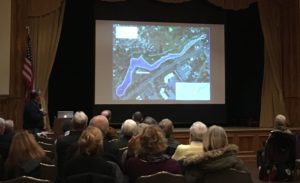On January 24, 2017, the Historical Society of Moorestown hosted the Annual Joint Meeting at the Community House with several other Moorestown organizations: the Moorestown Improvement Association (MIA), Save the Environment of Moorestown (STEM), the Pompeston Creek Watershed Association, and the Moorestown Garden Club. This was the first Annual Joint Meeting in which the Historical Society has participated. The other groups presented information about their latest projects and the challenges that they face. Margo Foster, Treasurer of the Friends of Percheron Park, also gave an update on the proposed park.
Lenny Wagner, the President of the Historical Society, then provided an overview of the Society’s history, mission, notable artifacts, and latest exhibit. Mr. Wagner mentioned the ongoing History Rocks! exhibit, which displays a mind-boggling array of Native American tools, weapons, and other every-day items, many of which are thousands of years old, and all of which were discovered in recent, Moorestown archaeological digs. He stated that the mission of the Society is to preserve data, collect and preserve material things, and perpetuate the memory of those who made Moorestown what it is today. He also noted the resources of the Society, which include a nationally-recognized collection of quilts, several centuries-old grandfather clocks, 18th, 19th, and 20th century clothing, and archives that allow the Society to provide, among other things, genealogy services, as well as resources that Moorestown residents and others may peruse, including maps, books and yearbooks, photos, and family archives.
The next speaker for the evening was Chet Dawson, chairman of the Moorestown Open Space Advisory Committee, whose informative, insightful talk was called, “Strawbridge Lake Park: Then, Now, and The Future.” Mr. Dawson said that the site was originally a swamp, and got its start as a park following donations of various properties from local residents, including the Strawbridge family. Construction commenced in the 1930s with funding and workers from the New Deal’s Works Progress Administration. Then came dredging, conducted in the 1950s and 60s, and from 1998 to 2001.
Pollution has been a consistent problem. The U.S. Environmental Protection Agency and the N.J. Department of Environmental Protection have indicated that the water contains too much phosphorus and that fish in the lake are contaminated with the insecticide chlordane. The lake is also plagued by sedimentation and the overgrowth of invasive plants such as Japanese Knotweed, Purple Loosestrife, and macrophytes, the latter of which resemble water lilies. Poison ivy has also been ubiquitous, and the lake is in need of different species of fish that will consume the overabundance of plankton in the water.
Mr. Dawson said that the environmental engineering firm, Princeton Hydro, has assisted with monitoring water quality, analyzing the watershed, harvesting weeds, and studying the build-up of sediment. Looking toward the future, the lake will need non-invasive plantings that can help discourage sedimentation, and a restoration of the lake’s shoreline. A new program, “Adopt the Lakefront,” invites people to receive training in maintaining portions of the lake and has been very successful. Clean-up of weeds has yielded some dividends. Poison ivy and other overgrowth have been removed so that some trails and benches are visible and usable again.
Maintenance of the park is partly funded by a grant from Burlington County. Mr. Dawson stated that he plans on contacting Rutgers and the Burlington County Soil Conservation District for additional assistance.
-Liz Rosenthal




